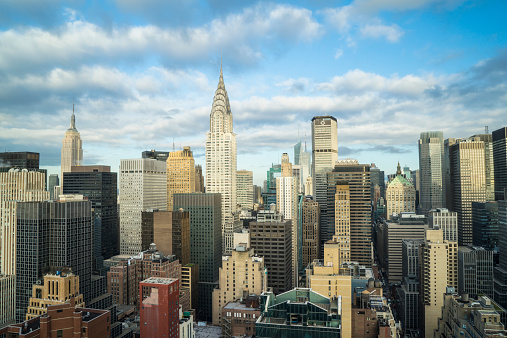
If any of us want to make a dent in the adverse effects of climate change in our lifetimes, we’ll need all hands on deck. That, in fact, is one of the core tenants of the contemporary environmental justice movement.
Proponents of environmental justice point toward crises looming on the horizon: President Obama is urging new and quick action in reducing carbon emissions and greenhouse gases; California is strategizing a way past its crippling drought; and urban megacities are searching for new models of development that use less resources and generate less waste.
But the project of ensuring a secure future for our planet can’t rely on the innovation of science alone. We need economic innovators, too. That was the message from Peggy Shepard, executive director at WE ACT for Environmental Justice, a New York-based advocacy organization, at a recent event at The Museum of the City of New York, co-presented by the Museum and New America NYC.
Shepard was joined in discussion by Ashley White, a young graduate of the Green City Force Corps; Bomee Jung, Deputy Director of the New York City Office of Enterprise Community Partners, Inc.; and Donnel Baird, founder of BlocPower, all of whom confronted head on common assumptions that sustainable development is more expensive and makes little economic sense. On the contrary, a healthy environment requires — and helps reinforce — a healthy economy.
Shepard, who co-founded WE ACT almost 25 years ago, first got turned on to the intersection between environment and economy as the Democratic district leader in her West Harlem neighborhood, where various utility mismanagement struggles came across her radar. Long-neglected and releasing noxious emissions into a residential neighborhood already plagued by poor levels of air quality, the North River Sewage Treatment Plant was a particular problem in Shepard’s district. Another was the absence of an efficient and functional bus depot in northern Manhattan.
The green benefits for the community in advocating for a more environmentally compliant treatment facility and an alternative fuel-operated bus depot were obvious. But WE ACT managed to achieve those benefits while simultaneously creating new jobs and ensuring more long-term government accountability in maintaining both facilities. In both cases, the community was key to a successful outcome, Shepard said. WE ACT’s wins were directly born out of using “models of community organizing and public policy [that allow] residents [to] integrate in and directly influence policy.”
WE ACT’s community-centered approach has caught on in addressing all types of environmental and economic issues — affordable housing development, urban gardening and food distribution, and alternative energy, to name a few.
With her work with Green City Force Corps, White acknowledged the constructive power of the community in the huge gains her organization has made. They have planted urban farms in otherwise unused lots which have yielded 3.6 tons of new of produce by and for residents of Red Hook, Brooklyn, a lower-resourced neighborhood often considered a “food desert.”
In many of the same communities, Jung’s work has transformed amassed assets – the resources accrued by developers through market-race contracts along with the government and tax incentives they receive for committing to new ownership and new building within the city — directly into policy solutions by adjusting city planning regulations for building contracts to include provisions for affordable housing developments that adhere to higher environmental standards. At BlocPower, Baird is leading the effort to invest in public-private partnerships and employ solar and energy efficiency technology to slash both energy consumption and cost.
Taken together, these four pioneers are just a few of the cohort of entrepreneurs working to prove that—through the right combined forces of local empowerment, public and government investment, and private sector support—we can be greener, healthier, and more productive while becoming more economically viable.
To be sure, there’s still work to be done. Shepard observed that government still hasn’t become effectively responsive to community needs. If our environmental footprint is going to get any better, Shepard noted, residents and neighborhood stakeholders have to be put at “the center of efforts for change so they become informed and empowered enough to take their own actions.” Just think: if more residents and fewer bureaucrats were invited to testify in front of city planning commissions and participate in green task forces, how much more consensus and momentum could be generated?
If urban green innovators like Shepard, White, Baird, and Jung are any indication, the environmental-economic future looks bright, but that doesn’t mean they they’re resting comfortably on the laurels of their breakthroughs. To the contrary, they’re always thinking about the next big benchmark for progress. In a society where dollars gained and lost are the go-to arbiters of risk and success, there are still too few companies that see their business impacts outside of environmental terms, and vice versa. But if we see environmental justice as connected to — and often the same as — economic justice, they both win.
As Shepard put it, environmental activism isn’t just about “stopping the bad stuff,” but about cultivating a system that creates the new — new technology, new partnerships, and (sooner than we think) new ways of thinking about the world we all want to live in.
Tyler S. Bugg is the New America NYC associate for New America. This piece was originally published in New America’s digital magazine, The Weekly Wonk. Sign up to get it delivered to your inbox each Thursday here, and follow @New America on Twitter.
More Must-Reads from TIME
- Donald Trump Is TIME's 2024 Person of the Year
- Why We Chose Trump as Person of the Year
- Is Intermittent Fasting Good or Bad for You?
- The 100 Must-Read Books of 2024
- The 20 Best Christmas TV Episodes
- Column: If Optimism Feels Ridiculous Now, Try Hope
- The Future of Climate Action Is Trade Policy
- Merle Bombardieri Is Helping People Make the Baby Decision
Contact us at letters@time.com